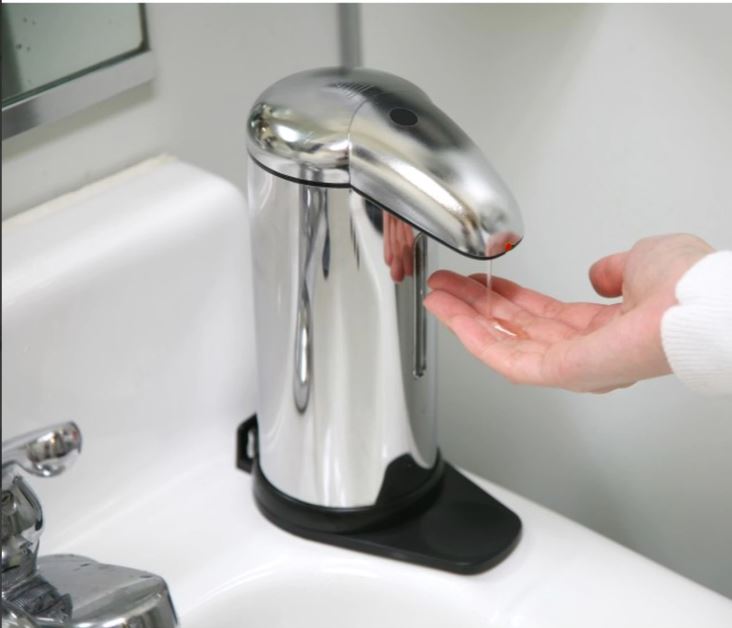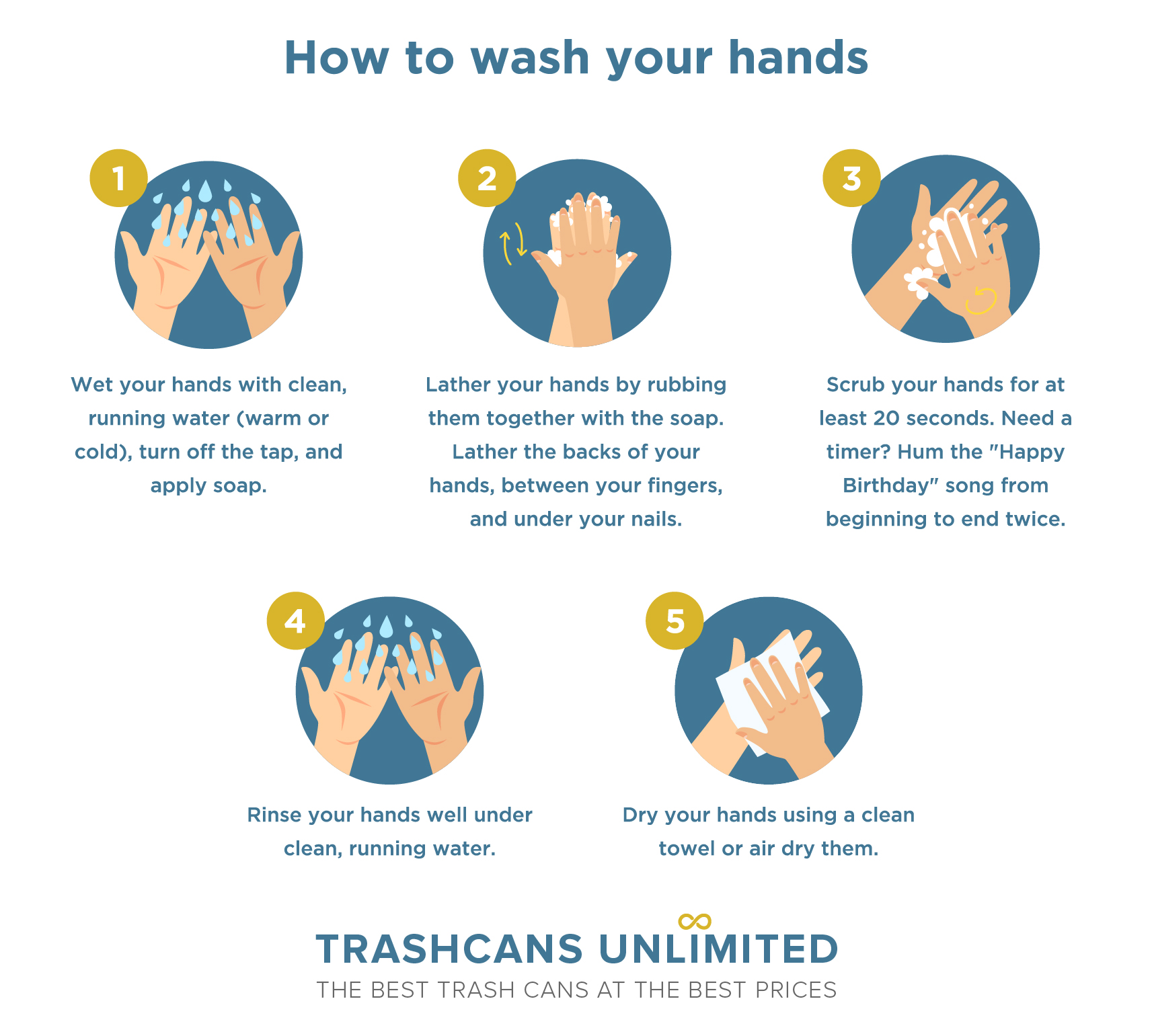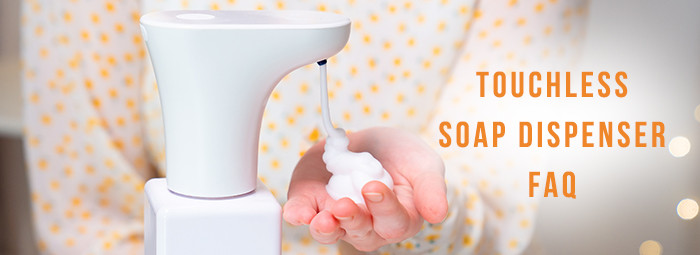As COVID-19 continues to be a threat, many people have sanitation on their minds. As we start to work through new paradigms for what a cleaner world might look like, more products than ever before are becoming touch-free.
A deep irony of a lot of public health and sanitation issues is that the areas in which we get things clean can become larger and larger hot spots for germs to live and spread. A soap spout that you’re having to touch to use can create germ problems with the contact required. Because of this, touchless soap dispensers are becoming commonplace, along with touchless faucets and hand dryers. Many of these are starting to make their way to homes and public spaces, which is a great thing.
Here, we’ll take you through common questions about touchless soap dispensers, as well as soaps and sanitizers.

1. What is the Best Touchless Soap Dispenser?
Trash Cans Unlimited offers one of the highest quality touchless soap dispensers on the market: the iTouchless Stainless Steel EZ Automatic Soap Dispenser. The sleek stainless steel design adds a modern touch to any bathroom, and it includes a unique wall-mount docking holder so you can easily place it on the wall or the counter at any time.
It’s compact, battery operated, and it includes a convenient soap indicator window so you can easily tell when the soap is getting low. You can even adjust the dispensing amount with a simple touch of a button. It’s not just for soap either, you can fill it with lotions, detergents, and anti-bacterial gels.
If you’re still shopping around for other options, the “best” touchless soap dispenser can depend on several different factors. Here’s what you want to consider.
- Wall Mounted vs Countertop - This usually depends mostly on personal preference and if there is enough space on the counter or the wall. It’s also important to remember to make sure it’s within reach of the sink and accessible to everyone. The nice thing about the iTouchless Stainless Steel EZ Automatic Soap Dispenser is that you can easily switch between putting it on the wall or the counter
- Capacity - If the dispenser is too small for what it’s being used for, you’ll have to refill it more, and there’s a greater risk of microbial contamination. If the dispenser is too large, the soap can sit there a while which increases the risk of microbial growth if it has been contaminated.
- Material - Stainless steel is probably the best choice for industrial and commercial applications, but after that, it becomes a matter of taste: plastic, chrome, brushed nickel, and ceramic are all good options.
- Power - Most touchless soap dispensers have batteries or an outlet plugin option. We recommend batteries for the most convenience.
2. Can You Put Hand Sanitizer in a Soap Dispenser?
Absolutely, there’s nothing about hand sanitizer that makes it unfit for a soap dispenser. Make sure you indicate that it is indeed a hand sanitizer dispenser and not a soap dispenser to avoid confusion.
3. Are soap dispensers dirty?
Yes and no. Our hands come into contact with soap dispensers when they are dirty in order to clean them. The germs that are on our hands often get transmitted to the soap dispenser when we touch it. Usually this isn’t a big deal, because a dollop of soap is dispensed into our hands right after touching the dispenser, but not everyone follows proper hand washing procedures.
If the dispenser is not adequately cleaned and sanitized often enough, a biofilm can form, which is a breeding ground for microbials that requires a particularly thorough cleaning to remove. If someone’s hands come into contact with the biofilm and does not follow proper handwashing protocol, there is a greater risk of infection and transmission of germs.

Below are the steps for proper hand washing protocol, according to the Center for Disease Control (CDC):
- Wet your hands with clean, running water (warm or cold), turn off the tap, and apply soap.
- Lather your hands by rubbing them together with the soap. Lather the backs of your hands, between your fingers, and under your nails.
- Scrub your hands for at least 20 seconds. Need a timer? Hum the “Happy Birthday” song from beginning to end twice.
- Rinse your hands well under clean, running water.
- Dry your hands using a clean towel or air dry them.
Also according to the CDC, you ought to be washing your hands—
- Before, during, and after preparing food
- Before eating food
- Before and after caring for someone who is sick
- Before and after treating a cut or wound
- Before and after touching your face
- After using the toilet
- After changing diapers or cleaning up a child who has used the toilet
- After blowing your nose, coughing, or sneezing
- After touching an animal, animal feed, or animal waste
- After handling pet food or pet treats
- After touching garbage
4. Can bacteria grow in liquid soap?
Washing with soap and water is universally recognized as an effective way to reduce the transmission of pathogens and microorganisms like bacteria. That being said, bacteria can grow anywhere, including soap, so the key is to keep bacteria from getting into the soap and growing in the soap. Most products have preservatives that prevent microbial growth in the event of contamination.
However, when refilling bulk soap dispensers, the soap reservoir can become contaminated if one’s hands come into contact with it. Sealed dispensers that use cartridges eliminate this risk. It’s also a good idea to wash your hands before refilling soap dispensers to decrease the risk of contamination, and frequent hand washing is always a good idea to help yourself and others around you stay healthy anyway.
5. How do you make homemade hand sanitizer?
There are a few formulas for homemade hand sanitizers. Below is a quick and easy way to create gel hand sanitizer at home. Make sure you use clean utensils and a clean work environment.
Homemade Hand Sanitizer Gel Ingredients & Instructions
- 2 parts isopropyl alcohol or ethanol (91–99% alcohol)
- 1 part aloe vera gel
- A few drops of essential oil, such as tea tree, eucalyptus, orange, etc.
Simply mix all ingredients together well, and store in a sealed container for immediate use.
Bulk Homemade Hand Sanitizer
The World Health Organization (WHO) has a formula for making 10 litre batches of homemade hand sanitizer with the following ingredients:
- Ethanol 96%: 8333 ml
- Hydrogen peroxide 3%: 417 ml
- Glycerol 98%: 145 ml
- Sterile distilled water, or cold boiled water: enough to meet 10 litre mark in container
This formula requires being sealed and left in “quarantine” for 72 hours before dividing the batch into smaller sealed containers for use.
6. Can you put foaming hand sanitizer in a regular dispenser?
Absolutely! You can put foaming hand sanitizer in a regular dispenser. The sanitizer will foam as it’s extruded from the dispenser, whether the dispenser is meant for foaming hand sanitizer or not.
7. Can germs live on a bar of soap?
Yes, germs can live on bar soap. Any surface where you leave behind dead skin, oils, and microbes is potentially a fertile growing area for bacteria. However, this doesn’t mean that bar soap is unsanitary or unhygienic. Because of the way handwashing works, it’s very unlikely that germs on a bar of soap are going to get transmitted to hands.
8. What is the best soap for killing bacteria?
Not all soaps are created equal. For instance, some dish soaps, hand soaps, laundry soaps are not antibacterial.
Only specifically labeled antibacterial soap actually kills bacteria, but most soaps are effective at removing bacteria, viruses, and other germs, thanks to their surfactant qualities.
On the topic of eliminating bacteria and other microorganisms, it’s important to be familiar with the different levels of clean and how they are achieved.
Antibacterial soaps are made to specifically target, remove, and kill bacteria. It’s important to remember not to overuse antibacterial soap as it can remove healthy bacteria and oils from the skin that help keep you healthy.
Sanitizers deactivate or reduce the number of microorganisms on a surface. Sanitizers are products like soap, which are more gentle than a disinfectant, and significantly reduce the risk of contamination and infection.
Disinfectants are used similarly to sanitizers, but they kill or deactivate close to 100% of microorganisms on a surface. These are the products that advertise the removal of 99.99% of germs.
Sterilizers eradicate any and all microorganisms that come into contact with them. Sterilization is a process that is more common in the medical field or lab sciences than it is in day to day life. Methods of sterilization range from incineration to irradiation.
9. Which soap brand kills the most bacteria?
There is no specific brand that kills more bacteria than any other. Antibacterial soap is the kind of soap that targets bacteria, and all soaps are effective at removing bacteria, viruses, and germs.
10. Which is better: foam or liquid soap?
Soap works by disrupting the bonds that allow microorganisms and pathogens like viruses and other germs. The surfactants that create bubbles and lather give the sign of this process working. That said, purely foaming hand soap can be less effective.
Mainly because of the agitation that it takes to get soap to foam when used conventionally. Even though foam might be less effective at sanitizing, it saves money, water, and resources required from using more soap. It’s an effective way to clean hands, but liquid soap may be more effective.
11. Is liquid soap as good as a bar of soap?
Absolutely! Liquid soap is as good as a bar of soap, and in some cases, it might be even better. It’s easier to get the proper amount of liquid soap on your hands and disperse it to effectively sanitize them than it is with a bar of soap. You can read more about the different types of soap and their pros and cons from the Minnesota Department of Health.
12. Why do soap dispensers turn green?
Usually, soap dispensers turn green because of oxidation, and it’s not inherently unsanitary, but it can become a breeding ground for microbes.
Other Ways to Stay Hygenic
Trashcans Unlimited provides excellent tools for creating a more hygienic environment, from touchless soap dispensers and wipe dispensers to trash cans and recycling receptacles. Our products are perfect for creating a more sanitary home, bathroom, gym, kitchen, workplace, or any public environment.

